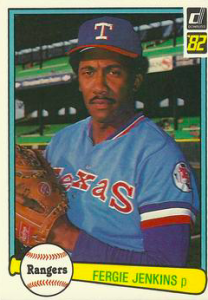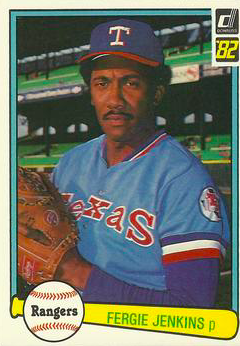October 2, 1974: Fergie Jenkins foils Hughes’s no-hit bid as Rangers take season finale from Twins

A paltry crowd of 2,570 fans showed up at Metropolitan Stadium as the two franchises formerly known as the Washington Senators squared off in their 1974 season finale. Neither team was playoff bound, though the Texas Rangers had challenged the Oakland A’s in the American League West for much of the season, and the pitching matchup seemed actually to be a mismatch in favor of Texas. The Twins sent September call-up Jim Hughes to the mound to make only his second major-league start, against 1971 National League Cy Young Award winner Ferguson Jenkins, who was resurgent after being shipped to Texas by the Chicago Cubs after a subpar 1973 season. On this day, Hughes exceeded expectations as he took a no-hit bid into the top of the sixth inning, until the future Hall of Famer Jenkins gave his team the edge with … his bat.
Texas manager Billy Martin had intended to start Jim Bibby on this day, so that the big right-hander could have a shot at his 20th victory of the season, but Bibby came down with the flu and Jenkins was pressed into duty.1 Martin also made the now-unorthodox move – in the American League, anyway – of letting Jenkins bat. Jenkins became the first AL pitcher to hit for himself from the beginning of the game and the first Rangers pitcher to hit for himself since the junior circuit had instituted the use of the designated hitter in 1973.2
Hughes showed that he was not intimidated by such a formidable foe as Jenkins, though his day hardly got off to an auspicious start. Speedy Dave Nelson drew a walk to lead off the game, took second on Lenny Randle’s grounder, and made it to third when Hughes uncorked a wild pitch with Jim Spencer at bat. Hughes extricated himself from danger by inducing consecutive groundouts by Spencer and Tom Grieve that denied Nelson the opportunity to score. After that, the Minnesota rookie settle into a groove and allowed only one additional baserunner – via a walk to Jim Sundberg in the third – for the next four innings. Though a perfect game had been out of the question from batter number one, Hughes had “Ranger hitters look[ing] like they were wearing cast iron underwear” as he flirted with a no-hitter.3
Jenkins, on the other hand, breezed through three Twins batters in the first but then had to navigate around traffic on the bases in the second and third innings. Craig Kusick led off the Twins’ half of the second with a single but was retired at second on Eric Soderholm’s fielder’s-choice grounder. After Larry Hisle flied out, Danny Thompson stroked a base hit to right field that advanced Soderholm to third base. Jenkins squelched the Twins’ hopes of breaking on top by striking out Luis Gomez.
In the bottom of the third, Steve Brye knocked a one-out double to left field and went to third on Steve Braun’s grounder. Martin had Jenkins issue an intentional walk to Tony Oliva, putting runners at the corners with two out. The strategy worked as Kusick hit a grounder to short that forced Oliva at second base to end the inning. After that, Jenkins settled into a pitchers’ duel with Hughes as he set the Twins down in order from the fourth inning through the sixth.
Jenkins’ task was made easier by the fact that Rod Carew, having already sewed up the AL batting title, was given the day off by Minnesota manager Frank Quilici. With his 1974 batting crown in hand, Carew had become the first AL player to win three consecutive batting championships since Ty Cobb had pulled off the feat from 1917 through 1919. Carew’s .364 batting average in 1974 also was the highest in the AL since Ted Williams batted .388 in 1957.
In the absence of the game’s premier hitting star, Jenkins, who had struck out in his first at-bat, took the opportunity to display some batting prowess of his own and rained on Hughes’ no-hit parade in the top of the sixth. In truth, Jenkins’ hit “was hardly a lethal shot.”4 His grounder up the third-base side “hit a divot left over from last Sunday’s Minnesota Vikings game” and took a bad bounce over the third baseman Soderholm’s head.5 Nonetheless, Hughes’ no-hitter was gone and the shutout would soon follow.
Nelson laid down a sacrifice bunt, but Hughes – who had fielded the ball cleanly – hesitated on the throw, which arrived at second base too late to retire Jenkins. Now Hughes momentarily lost his composure and, with Bob Jones at the plate, was called for a balk that allowed both Jenkins and Nelson to advance one base. Both runners had to hold as Jones grounded out to Kusick at first base, but then Spencer lined a single to center that drove in Jenkins for the first run of the game. Texas tried for another run via a suicide squeeze, but the result was a rally-killing, inning-ending double play as both Nelson and Spencer were thrown out.
The Rangers’ third and final hit off Hughes turned out to be the decisive blow of the contest as Grieve led off the top of the seventh inning with a solo home run to increase Texas’s lead to 2-0. From that point forward, Hughes allowed only one additional baserunner for the remainder of the game – Sundberg, who drew his second walk in the eighth – but the deficit was too much to overcome as the Twins scored their lone run on Soderholm’s solo homer in the bottom of the seventh.
Martin lifted Jenkins for pinch-hitter Mike Cubbage in the top of the eighth and then sent Steve Foucault to the hill to finish the final two innings. Foucault picked up seamlessly where Jenkins had left off and retired all six Twins batters he faced, striking out three of them. The final batter he faced was Harmon Killebrew, pinch-hitting for Larry Hisle, who struck out looking. After the game, “Killer” was asked if this had been his last game in a Twins uniform, to which question he responded, “I hope not. I said at the start of the season I’d know at season’s end if I wanted to play another year. I do, and I hope it’s with the Twins, but I guess [owner] Mr. Calvin] Griffith has the final say on that.”6 As it turned out, Killebrew, who had spent his entire career with the Washington/Minnesota franchise, ended up playing his 22nd and final season with the Kansas City Royals.
After Foucault set Killebrew down on strikes to earn his 12th save, the season was over for both teams. All that was left was for each to find the highlights of a campaign that ended without participation in the postseason. Jenkins had set a career high with 25 victories while striking out 225 batters and posting a 2.82 ERA over 328⅓ innings for the 84-76 Rangers. Texas skipper Martin asserted, “I’m voting for Ferguson Jenkins over Jim Hunter of Oakland for the Cy Young Award and I’m voting for Billy Martin as manager of the year.”7 While neither of those awards went to Martin’s selections, he had reason to be optimistic. Jenkins did receive the AL’s Comeback Player of the Year award, outfielder Jeff Burroughs was voted the AL MVP, and first baseman Mike Hargrove was named the AL Rookie of the Year.
Other than Carew’s batting crown, the outlook was not as rosy in the Twin Cities. Minnesota finished with an 82-80 overall record that was good for third place behind the Oakland A’s and Texas in the AL West. They were 48-33 at the Met, but drew only 662,401 fans in 77 dates, which put their attendance dead last in the AL. Griffith made pitching coach Bob Rodgers into a scapegoat and fired him. Quilici was so upset over the firing of Rodgers that he considered resigning in protest. He revealed, “Bobby [Rodgers] and I talked about that [resigning], but he said that I had a job to do here, and I have.”8 It was true that Minnesota’s pitching was average, but it was hardly the team’s primary shortcoming. Most notably, clutch hitting was in short supply as the 1974 Twins left 1,263 runners on base over the course of the season.9
Based upon his complete-game performance in 1974’s finale, Hughes was a potential bright spot for the future. He finished the 1975 season with a 16-14 ledger and a 3.82 ERA under the tutelage of new pitching coach Lee Stange, but stardom was not in the cards and the Twins released him in November 1977.
Sources
The author consulted baseball-reference.com for the game box score and both team and individual player statistics.
Notes
1 Mike Shropshire, “Jenkins Gives Texas 2-1 Finale,” Fort Worth Star-Telegram, October 3, 1974: 40.
2 “Fergie Foils No-Hitter Bid,” Dayton (Ohio) Journal Herald, October 3, 1974: 22; Merle Heryford, “Martin Rates Rangers Better With Winning Spirit for ’75,” The Sporting News, October 19, 1974: 29.
3 Shropshire.
4 Shropshire.
5 Shropshire.
6 Tom Briere, “Twins Drop Finale – and Coach,” Minneapolis Star Tribune, October 3, 1974: 35.
7 Briere.
8 Briere: 33, 35.
9 Briere: 35. The 1975 edition of The Sporting News Official Baseball Guide supports the figure given here; however, baseball-reference.com lists the figure as 1,262, a minor discrepancy that does not detract from the fact that the Twins had trouble bringing runners home in the 1974 season.
Additional Stats
Texas Rangers 2
Minnesota Twins 1
Metropolitan Stadium
Bloomington, MN
Box Score + PBP:
Corrections? Additions?
If you can help us improve this game story, contact us.


